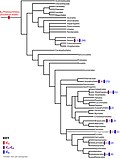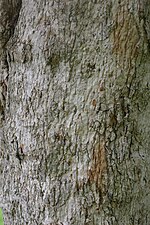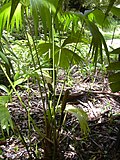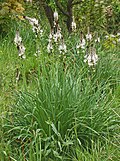The APG III system of flowering plant classification is the third version of a modern, mostly molecular-based, system of plant taxonomy being developed...
47 KB (3,194 words) - 04:17, 8 April 2024
The APG IV system of flowering plant classification is the fourth version of a modern, mostly molecular-based, system of plant taxonomy for flowering...
40 KB (2,558 words) - 13:57, 8 April 2024
it was replaced by the improved APG II in 2003, APG III system in 2009 and APG IV system in 2016. The original APG system is unusual in being based,...
20 KB (1,426 words) - 19:08, 1 June 2024
Angiosperm Phylogeny Group (section APG III (2009))
angiosperm classification. As of 2016[update], three revisions have been published, in 2003 (APG II), in 2009 (APG III) and in 2016 (APG IV), each superseding...
33 KB (3,527 words) - 05:32, 8 April 2024
The APG II system (Angiosperm Phylogeny Group II system) of plant classification is the second, now obsolete, version of a modern, mostly molecular-based...
7 KB (650 words) - 01:27, 20 October 2022
Plant taxonomy (redirect from Classification of plants)
t01-1-00158.x. APG (2009). "An update of the Angiosperm Phylogeny Group classification for the orders and families of flowering plants: APG III". Botanical...
14 KB (1,567 words) - 22:57, 9 May 2024
the family Amaryllidaceae, order Asparagales. The most recent APG classification, APG III, takes a broad view of the Amaryllidaceae, which then has three...
45 KB (3,900 words) - 02:46, 8 April 2024
rambutans; mangos and cashews; frankincense and myrrh; mahogany and neem. The APG III system of 2009 includes it in the clade malvids (in rosids, in eudicots)...
5 KB (407 words) - 02:55, 8 April 2024
considered a taxon incertae sedis in the Angiosperm Phylogeny Group classification (APG III). Molecular analyses based on a recent collection from Guatemala...
4 KB (363 words) - 15:30, 17 April 2024
Caryophyllales (section APG III)
update of the Angiosperm Phylogeny Group classification for the orders and families of flowering plants: APG III". Botanical Journal of the Linnean Society...
12 KB (1,032 words) - 03:35, 8 April 2024
publishing of the Eucalyptus grandis genome in June 2014. The APG III system of classification for angiosperms still places it within the eurosids; this is...
8 KB (648 words) - 05:33, 22 April 2024
the Myrothamnaceae were in the Hamamelids. In modern classification systems, such as APG III and APG IV, this order was the first to derive from the core...
4 KB (415 words) - 03:01, 8 April 2024
The APG III phylogenetic tree for the asterids is: Angiosperm Phylogeny Group (2009). "An update of the Angiosperm Phylogeny Group classification for...
3 KB (146 words) - 03:03, 8 April 2024
Rhynchocalyx (formerly of the Rhynchocalycaceae) under the APG III system of classification. Olinia emarginata Olinia cymosa Wikimedia Commons has media...
2 KB (129 words) - 03:30, 8 April 2024
potentially containing one family, Dilleniaceae. The APG III system of 2009, like the earlier APG II system of 2003, left the Dilleniaceae unplaced as...
2 KB (170 words) - 03:02, 8 April 2024
Penaeaceae along with Olinia (formerly of the Oliniaceae) under the APG III system of classification. Rhynchocalyx is endemic to the KwaZulu-Cape coastal forest...
2 KB (174 words) - 05:45, 8 April 2024
under various classification schemes. Under the 2009 APG III system the Francoaceae were included within the Melianthaceae. In the 2016 APG IV system the...
3 KB (245 words) - 02:58, 8 April 2024
woody flowering plants. The name is newly accepted in the APG III system of plant taxonomy. APG II system, of 2003, mentions the possibility of recognizing...
2 KB (193 words) - 16:17, 25 April 2024
update of the Angiosperm Phylogeny Group classification for the orders and families of flowering plants: APG III". Botanical Journal of the Linnean Society...
10 KB (983 words) - 03:35, 8 April 2024
in 9 genera. The family Penaeaceae was expanded under the APG III system of classification with the inclusion of the genera Olinia (formerly in the monogeneric...
2 KB (192 words) - 03:52, 8 April 2024
flowering plants. The order did not exist in the 2009 APG III system, and was added in the 2016 APG IV system, including two families, Icacinaceae and Oncothecaceae...
2 KB (162 words) - 04:02, 8 April 2024
In the APG IV system (2016) for the classification of flowering plants, the name asterids denotes a clade (a monophyletic group). Asterids is the largest...
8 KB (649 words) - 13:31, 30 June 2024
update of the Angiosperm Phylogeny Group classification for the orders and families of flowering plants: APG III". Botanical Journal of the Linnean Society...
20 KB (1,417 words) - 05:52, 8 April 2024
update of the Angiosperm Phylogeny Group classification for the orders and families of flowering plants: APG III", Botanical Journal of the Linnean Society...
4 KB (324 words) - 13:37, 30 June 2024
update of the Angiosperm Phylogeny Group classification for the orders and families of flowering plants: APG III". Botanical Journal of the Linnean Society...
4 KB (400 words) - 05:13, 8 April 2024
Commelinids (section APG system)
clade has been recognized in all four APG classification systems. The commelinids of APG II (2003) and APG III (2009) contain essentially the same plants...
12 KB (837 words) - 13:13, 30 June 2024
"lizard's-tail family". The APG IV system (2016; unchanged from the 2009 APG III system, the 2003 APG II system and the 1998 APG system) assigned it to the...
4 KB (333 words) - 03:22, 8 April 2024
L. Reveal in their 2009 article "A phylogenetic classification of the land plants to accompany APG III." This subclass comprises the cycads, which include...
2 KB (134 words) - 19:06, 22 March 2024
Geraniales (section APG)
optional synonym. Thus the number of families was reduced to four. The APG III classification (2009) was typical of newer arrangements. In this definition, Hypseocharitaceae...
19 KB (1,825 words) - 05:23, 8 April 2024
Proteales (section Classification)
update of the Angiosperm Phylogeny Group classification for the orders and families of flowering plants: APG III", Botanical Journal of the Linnean Society...
6 KB (600 words) - 16:13, 26 June 2024
























